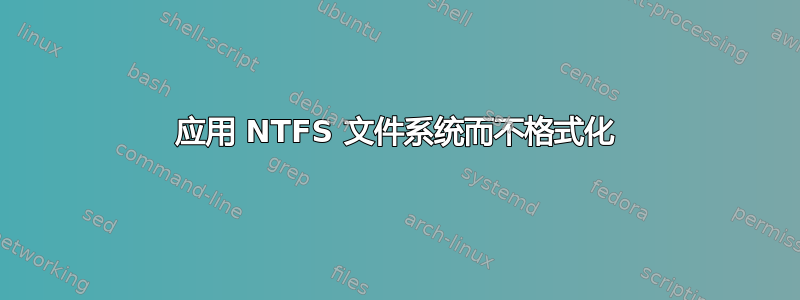
我删除了驱动器上的文件系统(三年前)。磁盘未格式化,因为我想恢复我的文件并且我没有 Windows/Linux 操作系统。
是否可以不格式化就应用NTFS文件系统?
注 0:
[joseluisbz@centos ~]$ sudo mount -t ntfs /dev/sda2 /run/media/joseluisbz/recover
mount: /run/media/joseluisbz/recover: wrong fs type, bad option, bad superblock on /dev/sda2, missing codepage or helper program, or other error.
[joseluisbz@centos ~]$
这不起作用。
注 1:
[joseluisbz@centos ~]$ sudo fdisk /dev/sda
Welcome to fdisk (util-linux 2.32.1).
Changes will remain in memory only, until you decide to write them.
Be careful before using the write command.
Command (m for help): t
Partition number (1-3, default 3): 2
Hex code (type L to list all codes): 7
Changed type of partition 'HPFS/NTFS/exFAT' to 'HPFS/NTFS/exFAT'.
Command (m for help): w
The partition table has been altered.
Syncing disks.
[joseluisbz@centos ~]$
不幸的是,重新加载GParted我得到相同的结果。
笔记2:
[joseluisbz@centos ~]$ sudo gdisk /dev/sda
GPT fdisk (gdisk) version 1.0.3
Partition table scan:
MBR: MBR only
BSD: not present
APM: not present
GPT: not present
***************************************************************
Found invalid GPT and valid MBR; converting MBR to GPT format
in memory. THIS OPERATION IS POTENTIALLY DESTRUCTIVE! Exit by
typing 'q' if you don't want to convert your MBR partitions
to GPT format!
***************************************************************
Command (? for help): ?
b back up GPT data to a file
c change a partition's name
d delete a partition
i show detailed information on a partition
l list known partition types
n add a new partition
o create a new empty GUID partition table (GPT)
p print the partition table
q quit without saving changes
r recovery and transformation options (experts only)
s sort partitions
t change a partition's type code
v verify disk
w write table to disk and exit
x extra functionality (experts only)
? print this menu
Command (? for help): l
0700 Microsoft basic data 0c01 Microsoft reserved 2700 Windows RE
3000 ONIE boot 3001 ONIE config 3900 Plan 9
4100 PowerPC PReP boot 4200 Windows LDM data 4201 Windows LDM metadata
4202 Windows Storage Spac 7501 IBM GPFS 7f00 ChromeOS kernel
7f01 ChromeOS root 7f02 ChromeOS reserved 8200 Linux swap
8300 Linux filesystem 8301 Linux reserved 8302 Linux /home
8303 Linux x86 root (/) 8304 Linux x86-64 root (/ 8305 Linux ARM64 root (/)
8306 Linux /srv 8307 Linux ARM32 root (/) 8400 Intel Rapid Start
8e00 Linux LVM a000 Android bootloader a001 Android bootloader 2
a002 Android boot a003 Android recovery a004 Android misc
a005 Android metadata a006 Android system a007 Android cache
a008 Android data a009 Android persistent a00a Android factory
a00b Android fastboot/ter a00c Android OEM a500 FreeBSD disklabel
a501 FreeBSD boot a502 FreeBSD swap a503 FreeBSD UFS
a504 FreeBSD ZFS a505 FreeBSD Vinum/RAID a580 Midnight BSD data
a581 Midnight BSD boot a582 Midnight BSD swap a583 Midnight BSD UFS
a584 Midnight BSD ZFS a585 Midnight BSD Vinum a600 OpenBSD disklabel
a800 Apple UFS a901 NetBSD swap a902 NetBSD FFS
a903 NetBSD LFS a904 NetBSD concatenated a905 NetBSD encrypted
a906 NetBSD RAID ab00 Recovery HD af00 Apple HFS/HFS+
af01 Apple RAID af02 Apple RAID offline af03 Apple label
Press the <Enter> key to see more codes:
af04 AppleTV recovery af05 Apple Core Storage af06 Apple SoftRAID Statu
af07 Apple SoftRAID Scrat af08 Apple SoftRAID Volum af09 Apple SoftRAID Cache
b300 QNX6 Power-Safe bc00 Acronis Secure Zone be00 Solaris boot
bf00 Solaris root bf01 Solaris /usr & Mac Z bf02 Solaris swap
bf03 Solaris backup bf04 Solaris /var bf05 Solaris /home
bf06 Solaris alternate se bf07 Solaris Reserved 1 bf08 Solaris Reserved 2
bf09 Solaris Reserved 3 bf0a Solaris Reserved 4 bf0b Solaris Reserved 5
c001 HP-UX data c002 HP-UX service e100 ONIE boot
e101 ONIE config ea00 Freedesktop $BOOT eb00 Haiku BFS
ed00 Sony system partitio ed01 Lenovo system partit ef00 EFI System
ef01 MBR partition scheme ef02 BIOS boot partition f800 Ceph OSD
f801 Ceph dm-crypt OSD f802 Ceph journal f803 Ceph dm-crypt journa
f804 Ceph disk in creatio f805 Ceph dm-crypt disk i fb00 VMWare VMFS
fb01 VMWare reserved fc00 VMWare kcore crash p fd00 Linux RAID
Command (? for help): i
Partition number (1-3): 2
Partition GUID code: EBD0A0A2-B9E5-4433-87C0-68B6B72699C7 (Microsoft basic data)
Partition unique GUID: 77E7B551-0B8E-463A-BCA2-71B6B555A241
First sector: 141787136 (at 67.6 GiB)
Last sector: 223705087 (at 106.7 GiB)
Partition size: 81917952 sectors (39.1 GiB)
Attribute flags: 0000000000000000
Partition name: 'Microsoft basic data'
Command (? for help):
我下一步需要做什么?
答案1
是的,您可以使用fdisk或gdisk任何其他控制台实用程序,它允许更改分区类型或创建分区而无需实际格式化它。
例如对于 fdisk 它将是:
sudo fdisk /dev/sda
t (change type)
2 (select the second)
7 (NTFS)
w (write and exit)
答案2
尝试
mount -r -t ntfs /dev/sda2 /mnt
这应该以只读 ( -r) 模式挂载分区。
这假设没有对分区进行任何操作。
您可能需要执行 fsck,即dosfsck首先使用 -n 选项。



